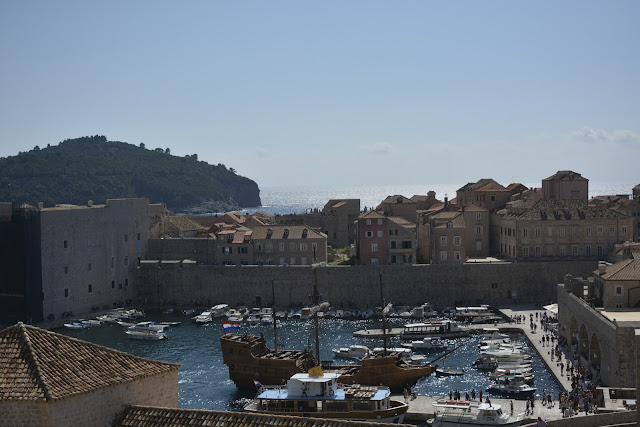Non Bene Pro Toto Libertas Venditura
Liberty cannot be sold for all the gold of the world
I had the once in a lifetime opportunity yesterday to walk the walls of Dubrovnik. What an amazing, enclosed city. In its ageless beauty it continues to survive, still, the onslaught of modern life outside and inside its walls. The walk was breathtaking and a photographer's dream. I had to soak up more of its history through research when I returned home.
What I love about Dubrovnik history:
- Very, very old dating back to 616 when Roman refuges and the Slavs settled around the rock of Laus
- Touched by, dominated by, conquered by or protected by many different influences over the years from its Slavic and Roman roots to the Byzantines (what the Christian empire was called in Constantinople), the Venetians (Venice was once a thriving state on its own), the Islamic rule (when Islam gained and regained its power in Constantinople), to the Normans, to the Serbians, to Ravenna, to Bosnia, to Russians, French, Austrian-Hungarian,to the German influence,
- Pure in its intent for liberty. The words inscribed on Fort Lovrjenac built in 1038 and which proved to be the mantra of its people for centuries to come: Non Bene Pro Toto Libertas Venditura which can be loosely translated to, Liberty cannot be sold for all the gold of the world. How beautiful is that coming from a renown trade center and an independent republic lasting for centuries.
- It was accepting of people other than Christians, like ...for example...the Jewish people. Though the Jewish population is not given the due it deserves in the middle ages...there was a very important Jewish population in Dubrovnik dating back to 1352. The third oldest synagogue in all of Europe was later built in 15th century here.
- Democratic and non autocratic in its leadership (for the most part) until after WWI when Peter I of Serbia became its first sovereign.
- Created an equal access for all social system that could make any Canadian pleased. The first public hospital in all the Balkans...Domus Christi ...was built in 1347. ( And just in time for the shadow of Black death soon fell upon the city (grad).) The first public school was opened in 1435. Protected its textile workers with a law in 1428
- Understood the necessity of disease prevention and health promotion. Was the first port to establish a quarantine in 1377. First pharmacy was founded in 1420. Clean water supply through the fountain that is still running clean water today was established in 1438. (I drank from that fountain yesterday...over a 1000 years later)
- Became completely built of stone as of 1413
- Home of famous art and artists like Blaz Jurije Trogiranin (painted the church in Ston), Marin Drzic (playwright) and Marco Marulic (poet)
- Self defended by the creation of magnificent walls and fortresses, that I walked upon yesterday, in the years between 1461 and 1570. The white gold manufactured in Ston was protected by the greatest and longest man-made wall, next to the Great Wall of China, in the entire world.
- Had a long peaceful and prosperous history under the rule of the Turkish sultan from 1526-1808 where it remained a fairly independent state?
- Its creation of the salt market in Ston in 1581 which showed great ingenuity and innovation making it the greatest salt ( white gold) industry in the world...even today.
- Its resiliency and ability to become stronger with adversity: It bounced back from the great fire, the black death of 1348, the great earthquake of 1667 and so many take overs and assaults on its walls...the greatest occurring during Croatia's War of Independence in 1992.
- Abolitionist Mandate. Its mandate against slave trading was bought about in 1416. The walls of Ston were built without slaves. People were paid for their work.
- Was able to remain fairly independent as a republic until Napolean's conquest in 1808. It fell under French rule until 1813 when the Congress of Vienna gave it to Austria-Hungary where it remained until 1915 when it joined with other countries to become the Kingdom of Croats, Serbs, and Slovenes and later the Kingdom of Yugoslavia in 1929. In 1943 during WWII it became a puppet state for the Axis, under Italian, then German occupation. After WWII it became a part of the Socialist Federal Republic of Yugoslavia and a communist state until the end of the War of Independence on November 12, 1995.
- King's Landing in the Game of Thrones. That series was shot here. The filming of this amazing series has boosted tourism in Croatia allowing it to increase its GNP
- and so much more....
Wow! That is a lot of history. I am just amazed by it all.
Please visit this amazing city if you ever have a chance, especially in the Winter time to help balance out the crowds and the tourist economy for this very special country. It is worth seeing. And you do not even have to be a Game of Thrones fan to appreciate it.
The ghosts that walk the stone walls here, I am sure, will reach out and grab you as they did me.
Again the pics will not do it justice until I get a chance to bring out the true colours of this place in Lightroom.
All is well.
Dubrovnik Online ( n.d.) Chronology of Dubrovnik fro 600 AD until 1808.https://www.dubrovnik-online.net/english/chronology.php
Wikepedia ( Sept 12, 2024) WWII in Yugoslavia. https://en.wikipedia.org/wiki/World_War_II_in_Yugoslavia#Axis_invasion_and_dismemberment_of_Yugoslavia
Wikepedia ( ) Hundred Years Croatian-Ottoman War. https://en.wikipedia.org/wiki/Hundred_Years%27_Croatian%E2%80%93Ottoman_War#:~:text=Nevertheless%2C%20the%20Ottoman%20Empire%20held,Herzegovina)%20which%20remained%20in%20Ottoman
dubrovnik -travel.net ( ) The History of Dubrovnik. https://www.dubrovnik-travel.net/history/



No comments:
Post a Comment